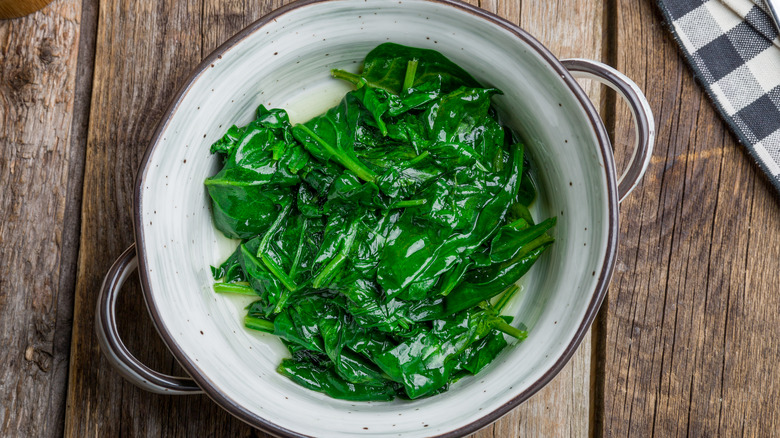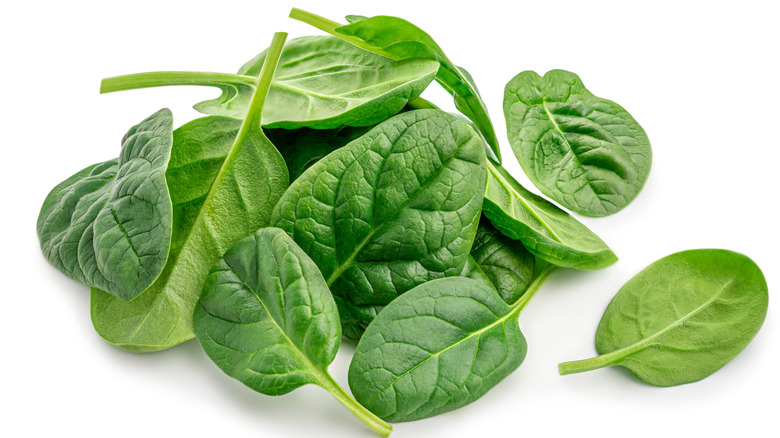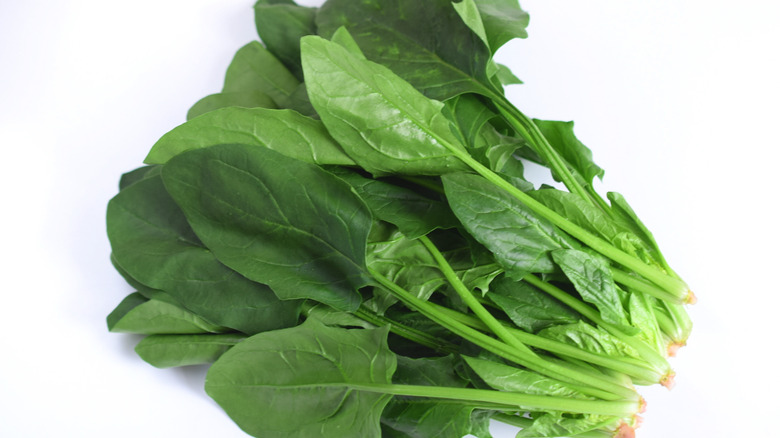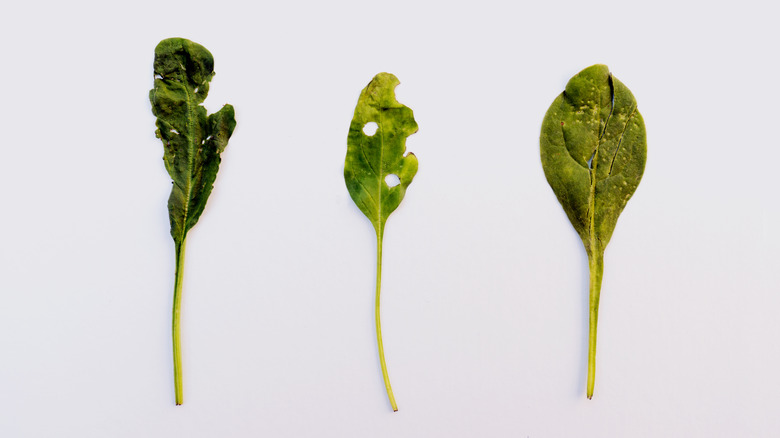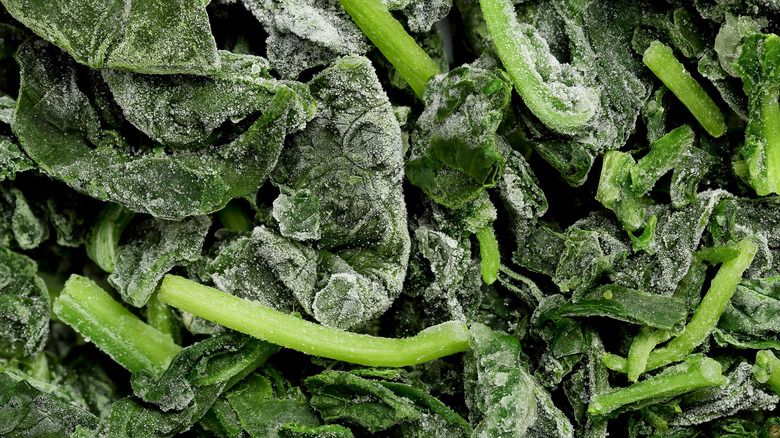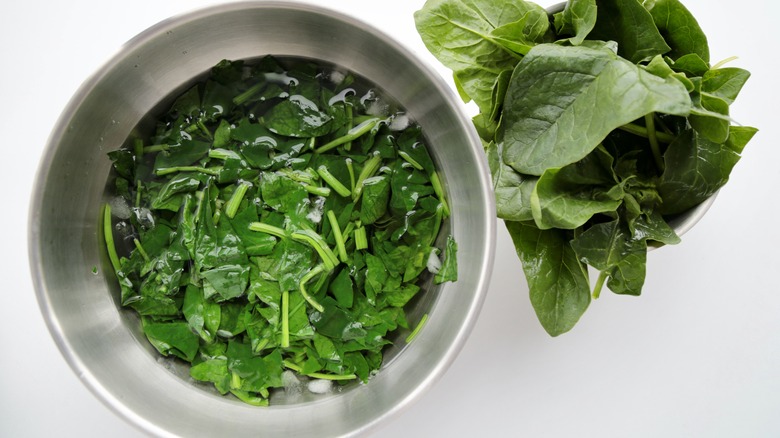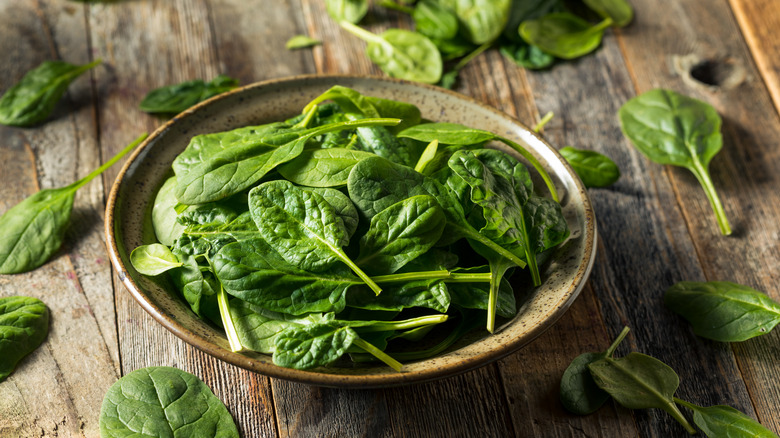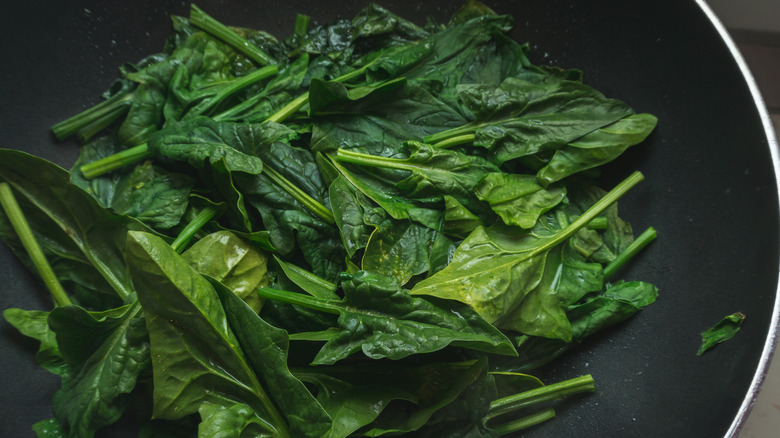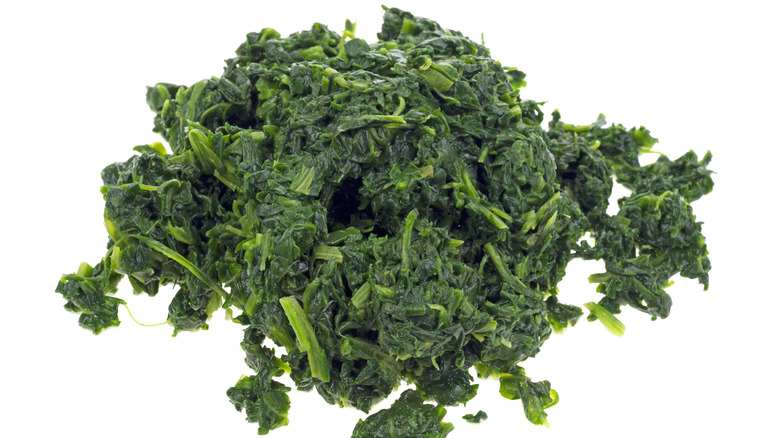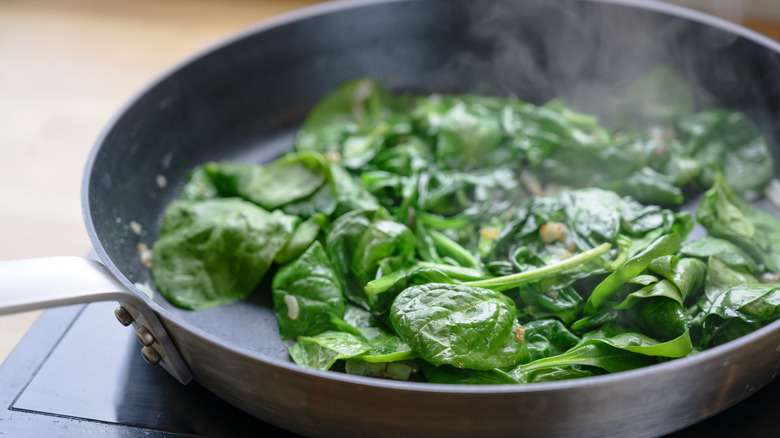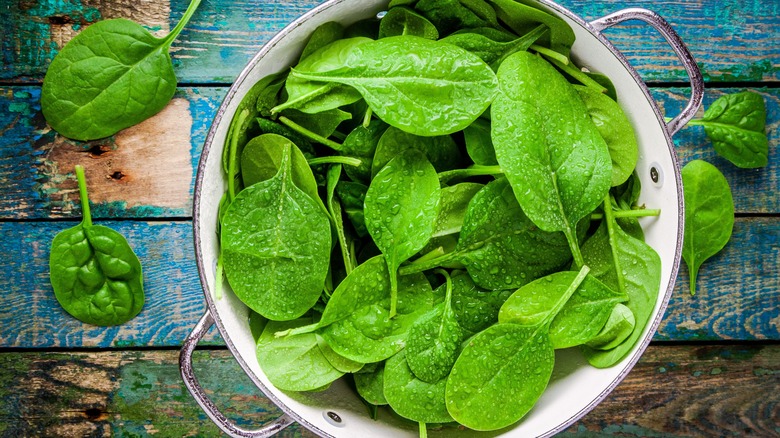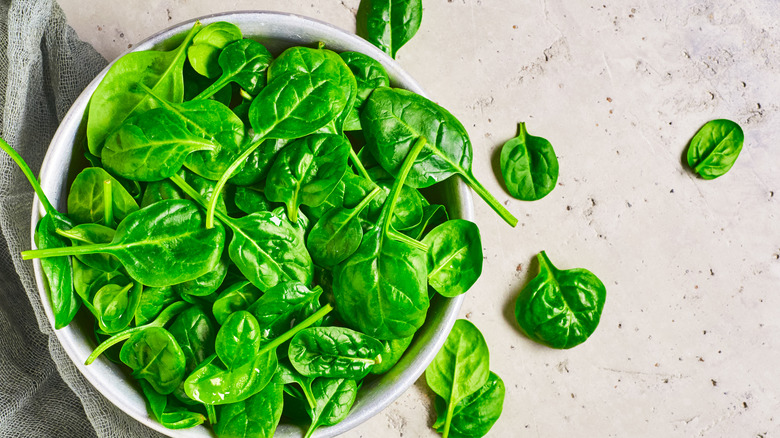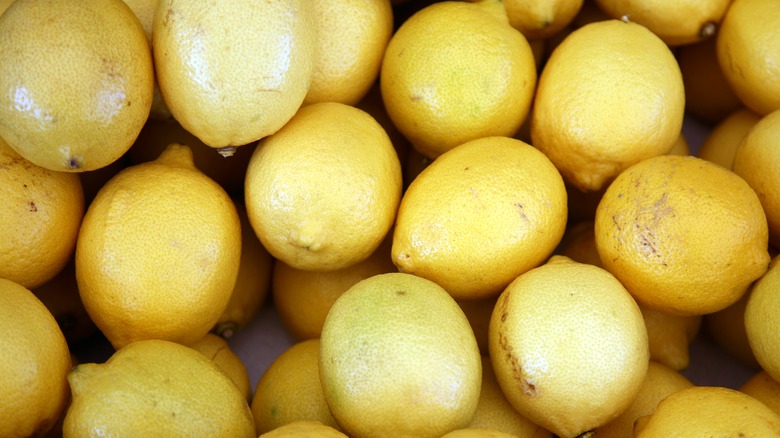12 Tips You Need When Cooking With Spinach
When you were a kid, you may have regarded spinach with some suspicion. Why would you want to eat leaves that shrink down into slimy green strands the second they're cooked? But as we get older, we start realizing just how delicious spinach can be. From classic spinach artichoke dips to nutrient-packed additions to good soup recipes, spinach can elevate the dish in both flavor and nutrition.
But if you're like a lot of people, you're probably making mistakes when it comes time to cook your spinach. It's not your fault — it's not exactly the most intuitive ingredient to cook with. However, messing up the spinach-cooking process can have disastrous consequences for your dish as a whole. If you're trying to avoid that, you should take a look at the essential tips you need when cooking spinach. By following these guidelines, you can guarantee that your spinach-heavy recipe will come out perfectly every time.
Only use baby spinach for salads
When you go to the grocery store in search of spinach, you may find yourself a bit overwhelmed by the different options to choose from. It can be difficult to know whether you should get the fresh stuff that comes in a bag, the larger variety that comes bundled together in the produce section, or the frozen greens. However, it just comes down to what you decide you want to make. For all the spinach salad lovers out there, it turns out that baby spinach is the way to go.
Baby spinach is more tender and mild in flavor than its more mature counterpart, which gives it a lovely flavor that's perfect when it's eaten raw. But when you take that same spinach and cook it down, it reduces to a slimy green mess. In fact, after you put a whole handful of baby spinach in some soup, you may notice that it almost seems to disappear completely, leaving nothing but an unwanted soggy green texture in your dish — probably not what you're looking for. Therefore, you're better off saving that baby spinach for your fresh dishes that don't require any cooking. Your salad will thank you for it.
Save the mature spinach for cooked recipes
So, what exactly should you do if you want to cook your spinach? You'll have to make your way to a different part of the produce section to find what you need. Instead of looking for the spinach that comes loose in bags, you should hunt down a bundle of spinach. You might notice that this variety of spinach has larger leaves and tougher stems. That's because you're dealing with mature spinach, which has less of the tenderness (and sliminess) that you'd expect from young greens.
Admittedly, cooking with mature spinach can take a bit more work than using baby spinach. This is because you may have to trim the ends of the spinach if the stems have become too tough — the last thing you want is to encounter a particularly tricky stem in your soup. However, once you do start cooking mature spinach, you'll find that it holds onto its texture very well. Instead of being left with a slimy green mess, you'll be able to enjoy a heartier texture and more developed flavor in your soup, stew, or other spinach dishes.
Don't forget to pick out the bad leaves
If you buy spinach a lot, you may have encountered a common problem: your spinach goes bad before you get the chance to eat it all. It's always a bummer when you realize that the entire bag of spinach has gone bad, but sometimes, just a few leaves start to go off. When that's the case, you don't have to throw all your spinach out — you can simply pick out the bad leaves and use the rest. This can help reduce food waste and stretch your grocery budget a bit further, ensuring that you won't have to take another trip to the grocery store to stock up on greens.
But what if you're planning on cooking your spinach anyway? You may assume it's still okay to eat the bad leaves, but you should probably just trash (or compost) them. While it's generally fine to eat slightly wilting spinach leaves, you'll definitely want to avoid leaves that have gone slimy. The same goes if you notice an unpleasant odor. After all, you don't want to snack on spinach that could potentially make you ill.
Learn how to use frozen spinach in your cooking
Too often, home cooks assume that frozen veggies should be avoided at all costs. Instead, you may want to pick up the freshest-looking spinach from the produce section at your local grocery store. However, you may be surprised that frozen spinach (and other frozen veggies) can actually be good for you. In fact, food scientists say that there's not a significant difference between frozen and fresh produce when it comes to nutritional value, so stocking up on frozen spinach can be an easy and cost-effective way to ensure you always have some healthy greens on hand.
You may be at a loss for what to do with frozen spinach, but the truth is, it can be used in most cooked recipes just like you'd just fresh spinach. Add it to pasta to give your noodles a nutritious boost, or add some frozen spinach to a soup to bulk it up and make it even more delicious. If you opt for chopping spinach, you can easily add it to meatloaf and casserole, and your little ones may not even realize it's there. Unfortunately, frozen spinach generally won't work well in recipes that call for fresh, uncooked spinach, so it's not ideal for salads. But with all the benefits that frozen spinach can provide, it makes sense to keep some in your freezer.
Make sure to blanch your spinach before freezing it
We've already talked about some of the benefits of using frozen spinach, which is helpful when you buy it already frozen. But what about if you want to save some of the fresh stuff for later? If you're worried your spinach is about to go bad, you can easily keep your spinach fresh by freezing it and using it whenever you're ready. The best way to preserve frozen spinach is by blanching it, which basically means boiling it for a very short time. After you boil the spinach, you'll dunk it in an ice bath, stopping the cooking process. Drain the spinach and let it dry before you freeze it.
Storing your frozen spinach in a freezer bag or a large airtight container is ideal, especially if you plan on using the spinach all at once. However, if you're planning on using the spinach in several different recipes (like for individual batches of smoothies, for example), you're better off storing your frozen spinach in smaller containers. That way, you won't have to thaw all your spinach to use a small portion of it. Freezing, thawing, and then re-freezing your spinach time and time again isn't ideal, so make sure you think about how you want to store your frozen spinach before you put it in the freezer.
Ensure you're using enough spinach for your recipe
If you're used to cooking with spinach, you might have noticed a strange phenomenon. You pull out a giant handful of greens to add to the soup that you're cooking. In fact, you think you're probably adding too much — you don't want the entire soup to be overtaken by leafy greens. But once you add the spinach to the soup and it starts wilting, it looks like you barely added any spinach at all. What gives? The real reason spinach shrivels when you cook it is that it contains a compound known as oxalic acid. Oxalic acid is quickly affected by heat; once it starts to break down, spinach leaves immediately start to shrivel. This is why that seemingly huge handful of spinach looks like next to nothing once you've added it to your soup.
Therefore, it's essential that you use enough spinach for the dish you're cooking — especially if you want the spinach flavor and texture to be noticeable. Of course, if you're following a recipe, you'll know how much spinach to add to a dish, but if you're eyeing it, you can probably add quite a bit more spinach than you're thinking. Start with a handful, see how quickly it cooks down, and go from there. At least you'll use it all up before it starts to go bad!
Don't overcook your spinach
Because spinach is such a tender, delicate green, it's exceptionally easy to overcook it, especially if you're preparing it with other ingredients. If you are, you need to make sure you add it at the very end of the cooking process. Cooking your spinach for too long in, say, a soup, can cause it to all but disappear completely into the rest of the dish. For those who plan on cooking spinach on its own, it's all about making sure you use enough heat. Instead of cooking your spinach low and slow, you'll want to cook it for a very short time on high heat. This will prevent it from cooking in its juices, which can take away from the green's fresh flavor and is a common mistake while cooking spinach.
If you're mixing it into other recipes, you'll have to cook for a while, your best bet is to blanch your spinach before using it. Remember, blanching is an easy process — you're just going to boil your spinach for a short time, just enough to it starts to wilt, then throw it in an ice bath to stop the cooking process. Finally, drain the spinach before you add it to your dish.
Squeeze spinach before adding it to dishes
If you are taking the blanched spinach route, you may think it's fine to take it out of its ice bath and throw it into whatever dish you're cooking. For some liquid-heavy dishes, like soups, this is fine. You're not going to run into any issues with that additional liquid. However, if you plan on sautéing your spinach, cooking it in oil, or adding it to a quiche or a casserole, you will want to ensure that you're working with mostly dry spinach.
But don't worry — you don't have to spend hours waiting for your spinach to dry after you blanch it and drain it. Instead, you can squeeze the excess liquid out of the leaves before adding them to your dish. Doing so will prevent you from adding in a ton of water where you don't want it. Yes, squeezing your blanched spinach does add another step to your spinach-cooking process, but trust us when we say that it'll make a big difference in the final product.
Season your spinach generously
If there's one mistake that home cooks make when they're preparing spinach, it's not seasoning it enough. Spinach tastes fine, but it's very green, and it doesn't have a ton of natural flavor other than a slight grassy bitterness. Sure, adding it to whatever dish you're making will cause it to take on some other flavors from the other ingredients, but you definitely shouldn't stop there if you want to ensure your spinach is as delicious as possible. That's why you should always season your spinach generously.
When you throw it into a pan, start with salt and pepper. These two essentials will be necessary in just about any savory recipe, so it's a smart place to start. From there, think about building flavor with other spices and herbs. Garlic can go a long way in spinach, giving it a pungency it's missing on its own. Even milder herbs like oregano or parsley can give spinach a punch of flavor and some freshness.
You may think that your spinach tastes fine without seasoning, and it probably does. But if you want to make sure you get a lot of greens into your diet, the best way to do it is to ensure that they always taste their best — seasoning is key.
Remember to rinse your spinach
Spinach can offer plenty of nutrients and health benefits, but you want to make sure that you're preparing your spinach in the healthiest way possible. Of course, this means preparing in a way that reaps as much of those nutrients as possible, but it also means following other food safety standards. Spinach can harbor harmful bacteria like E. coli that can make you and your family sick. That's probably the last thing you want when you cook up a bag of spinach. Therefore, it's essential to properly wash (read: rinse) your spinach.
First, you're going to want to wash your hands. After all, you don't want to contaminate your spinach after you wash it. Then, you can decide whether you want to soak your spinach. This largely depends on whether you can see visible dirt on the leaves. Since spinach can oftentimes arrive at the grocery store dirty, this soaking period will ensure that all the gunk and grime you don't want is washed down the drain.
Finally, it's time to rinse your spinach. Put it in a colander, and run water over the leaves, making sure that the water reaches all of them. Using a salad spinner can help speed up the drying process post-rinse. And remember, even when the bag is printed with an assurance like "triple-washed," wash it again!
Use a colander to cook your spinach
If you seem to have difficulty overcooking your spinach (no matter what you do), you may be on the lookout for a helpful hack. The hack you're searching for is called the colander trick. Instead of cooking your spinach directly in a pan or a pot on the stove, you're basically just going to use hot water to get the job done. First, place your uncooked spinach in a colander. Then, heat some water up until it's boiling. You can do this on the stove or in a kettle.
Once you've set yourself up, all you have to do is pour the boiling water over the colander filled with spinach. When you use this method, the spinach is only in contact with the water for a very short period, so it will not get overcooked. Instead, you're left with vibrantly green, fresh spinach leaves that taste amazing in whatever dish you choose.
Add a squeeze of lemon to your spinach
Spinach can be delicious, but let's be honest: Most of us eat it because it's good for our health. But what if you could ensure that you were making every single bite of spinach even more nutritious? Well, you can, and it turns out that it's pretty easy. According to Everyday Health, spinach is a great source of iron. However, to better absorb iron, you'll also want to get some vitamin D into your system, per Medical News Today.
Luckily, it can be relatively easy to incorporate some vitamin C into your meal. Of course, you can always pair your spinach with another side dish that happens to pack plenty of vitamin C (like bell peppers), but you can actually add vitamin C into the same dish as your spinach. Perhaps the easiest way of doing that is by adding a squeeze of lemon to your spinach. Not only does this help ensure you're absorbing that iron, but it also tastes delicious. Keep lemons on hand to add brightness, freshness, and vitamin C to your next spinach dish.
